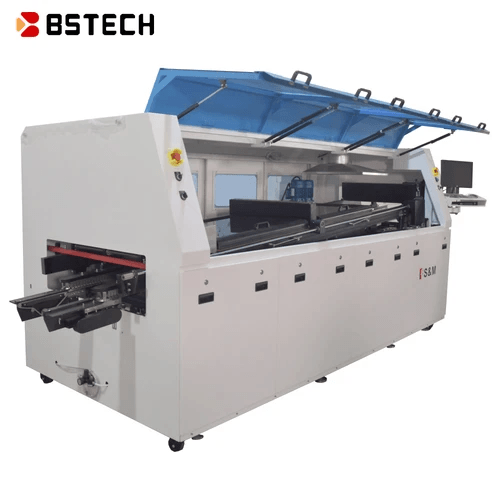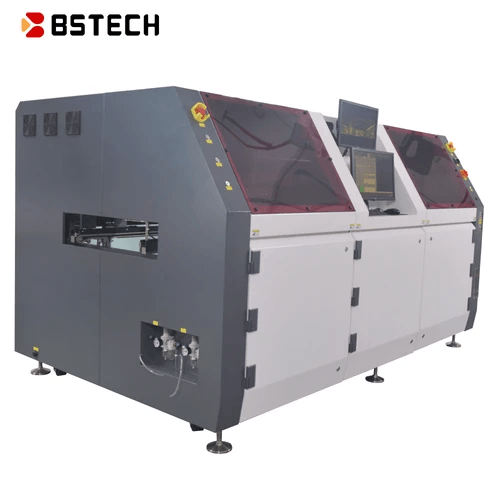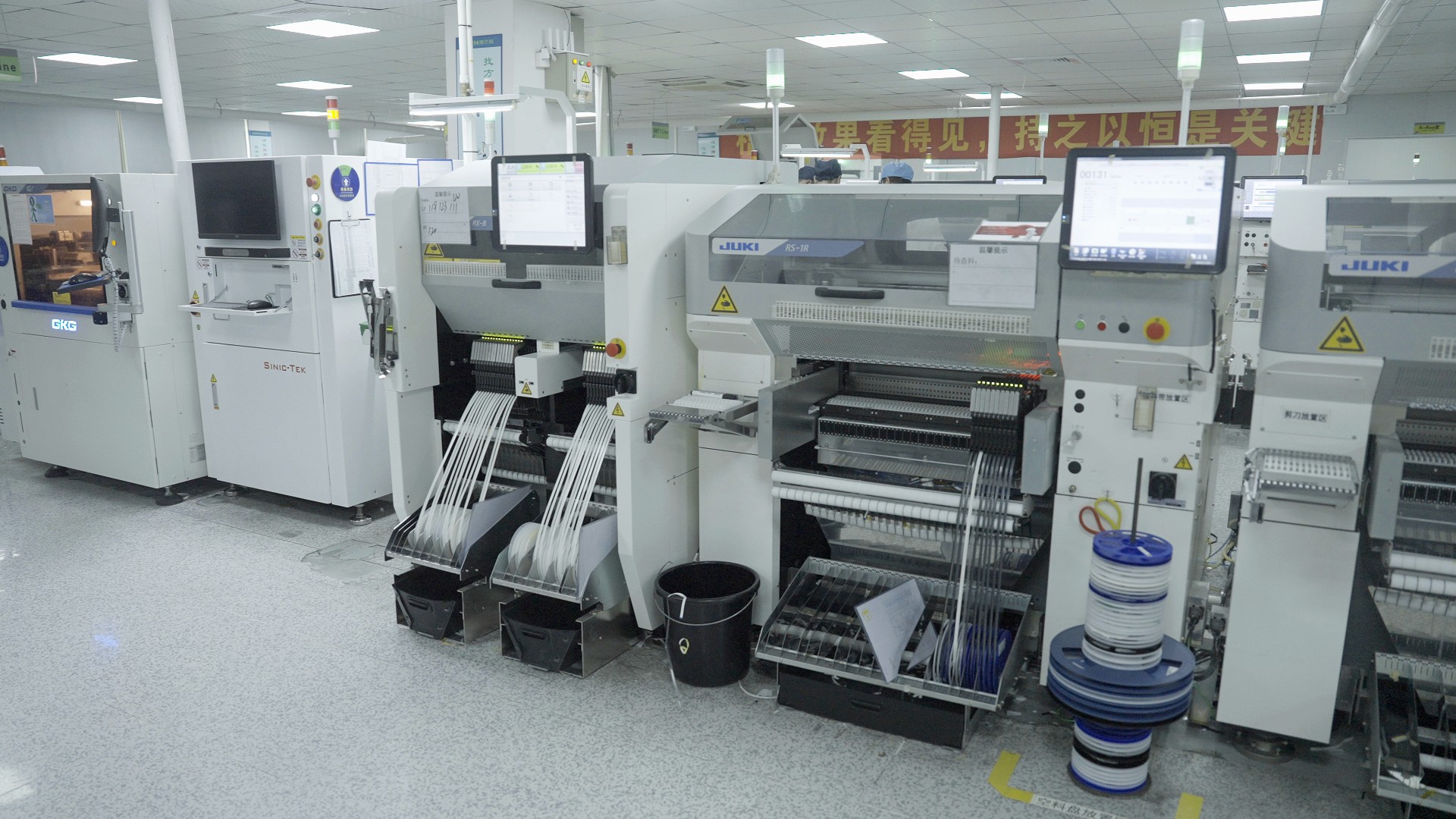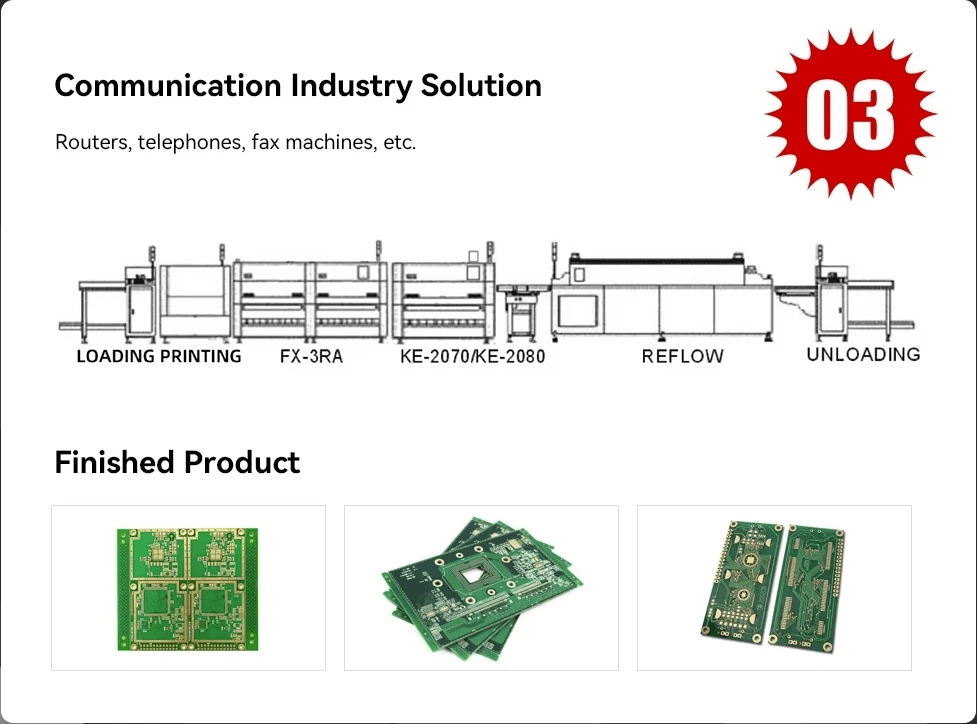Introduction
In the world of electronics manufacturing, precision is paramount, and that’s where selective solder machines come into play. These sophisticated devices are designed to apply solder & flux with pinpoint accuracy, ensuring that every connection on a PCB soldering assembly is robust and reliable. As technology continues to evolve, understanding the nuances of these machines becomes essential for anyone involved in SMT solder processes.
Understanding Selective Soldering Machines
Selective soldering machines are engineered to deliver targeted solder application, primarily for through-hole components on printed circuit boards (PCBs). Unlike traditional wave soldering machines that immerse entire assemblies in molten solder, selective machines use a focused approach that minimizes excess material and reduces waste. This method not only enhances the quality of the joints but also streamlines production by allowing for more complex designs without compromising reliability.
The Role of Bensun Technology
Bensun Technology stands at the forefront of SMT solutions, providing cutting-edge selective solder machines tailored to meet diverse industry needs. With a commitment to innovation and quality, Bensun ensures that their equipment integrates seamlessly into existing production lines while maximizing efficiency. Their expertise in developing customized solutions helps businesses navigate the complexities of modern electronics manufacturing.
Benefits of Using Selective Soldering
The advantages of using selective soldering over traditional methods like wave soldering are numerous and compelling. For starters, precision in applying solder & flux leads to reduced component damage and enhanced performance longevity. Additionally, this method proves cost-effective for high-volume production by minimizing material waste and increasing throughput—making it an attractive option for manufacturers looking to optimize their processes.
What is a Selective Soldering Machine?

Selective soldering machines are specialized tools designed to automate the soldering process, particularly in PCB manufacturing. Unlike traditional methods, these machines precisely apply solder and flux only where needed, minimizing waste and maximizing efficiency. Their functionality is pivotal in modern electronic assembly, ensuring high-quality connections without compromising component integrity.
Definition and Functionality
A selective solder machine operates by employing a combination of heated solder pots and precision nozzles to deliver molten solder directly onto specific joints on a printed circuit board (PCB). This targeted approach allows for the effective use of both solder and flux, making it ideal for complex assemblies with densely populated components. By focusing on individual connections rather than flooding an entire board, selective soldering enhances reliability while reducing the risk of thermal damage.
Components of Selective Solder Machines
The key components of a selective solder machine include the solder pot, which holds the molten solder; a flux application system that preps surfaces for bonding; and robotic arms or gantries that maneuver the nozzle with pinpoint accuracy. Additionally, these machines often feature advanced control systems that monitor temperature and flow rates to ensure optimal performance during PCB soldering processes. Together, these elements create an efficient workflow that streamlines production while maintaining high standards of quality.
Difference Between Selective and Wave Soldering
While both selective and wave soldering are essential techniques in SMT (Surface Mount Technology), they serve different purposes based on their operational mechanics. Wave soldering involves submerging the entire PCB into a wave of molten solder, making it suitable for through-hole components but less effective for delicate surface mount devices due to potential heat exposure. In contrast, selective solder machines provide targeted application of molten metal only where needed—perfect for complex boards—thus preserving sensitive electronics from unnecessary thermal stress.
The Importance of Solder & Flux in Production

In the world of PCB soldering, the importance of solder and flux cannot be overstated. These two components play a critical role in ensuring reliable connections and the overall quality of electronic assemblies. Understanding their types, functions, and best practices can significantly enhance the performance of selective solder machines and improve production efficiency.
Types of Solder Used in PCB Soldering
When it comes to solder used in PCB soldering, there are several types to choose from, each serving specific needs within the production process. Lead-based solders have been traditional favorites due to their excellent flow properties and reliability; however, with environmental regulations tightening, lead-free alternatives like SAC (Tin-Silver-Copper) alloys have gained popularity. Both types can be effectively used with selective solder machines or wave soldering machines, but selecting the right one is crucial for achieving optimal results.
In addition to these common types, there are specialty solders designed for unique applications such as high-temperature environments or specific component materials. Each type has its melting point and characteristics that affect how it interacts with flux during the soldering process. Thus, understanding these distinctions helps manufacturers choose appropriate options that align with their production requirements.
The Role of Flux in Soldering Processes
Flux is an unsung hero in the world of soldering processes; it promotes better adhesion between surfaces by removing oxides and impurities that can impede electrical connections. In selective solder machines, flux serves not just as a cleaning agent but also as a protective barrier against oxidation during heating. This ensures that when the molten solder meets the PCB pads and component leads, it forms strong bonds essential for durability.
Different types of flux are available—rosin-based fluxes provide excellent wetting properties while water-soluble fluxes offer easier cleaning post-soldering processes. Regardless of type, using an appropriate amount is vital; too little may lead to poor connections while too much can create residue issues on PCBs after assembly. Therefore, mastering flux application techniques is key for achieving high-quality results with both selective and wave soldering methods.
Best Practices for Solder and Flux Application
To maximize effectiveness when using a selective solder machine or any other type of soldering machine, adhering to best practices for applying both solder & flux is essential. First off, ensure your components are clean—dirt or grease can ruin even the best-quality materials! Proper storage conditions also matter; keep your solders dry and at stable temperatures to maintain their integrity before use.
Next up: application techniques! For instance, utilizing controlled pre-heating methods before introducing molten solder helps reduce thermal shock on sensitive components while enhancing flow characteristics during assembly processes. Lastly, regular maintenance checks on your equipment—including your wave soldering machine—will ensure consistent performance over time.
By following these guidelines regarding types of solders used in PCB applications along with effective flux management strategies will pave the way towards successful SMT solutions tailored specifically around your needs!
Advantages of Selective Soldering over Traditional Methods

Selective soldering has carved out a niche in the world of PCB soldering, offering distinct advantages over traditional methods like wave soldering. By utilizing a selective solder machine, manufacturers can achieve remarkable precision and efficiency, which are crucial in today’s fast-paced production environments. This section will delve into the key benefits that make selective soldering a preferred choice for many industries.
Precision in Soldering Processes
One of the standout features of a selective solder machine is its ability to deliver pinpoint accuracy during the soldering process. Unlike wave soldering machines that blanket an entire circuit board with molten solder, selective machines target specific areas, ensuring that only designated joints receive flux and solder. This precision minimizes excess application, leading to cleaner results and reducing the likelihood of bridging or shorts between components.
Moreover, this level of accuracy is particularly beneficial for complex PCBs with densely packed components where traditional methods may struggle. By using advanced programming and robotic arms, these machines can adapt to various designs and layouts seamlessly. The result? Higher quality assemblies with fewer defects—something every manufacturer strives for!
Reduced Component Damage
Another significant advantage of selective soldering is its ability to minimize damage to sensitive components during the PCB soldering process. Traditional wave soldering exposes all parts on a circuit board to heat simultaneously, which can be detrimental to delicate electronic components like capacitors or ICs (integrated circuits). In contrast, the controlled application of heat from a selective solder machine allows for much gentler treatment.
This targeted approach not only protects fragile parts but also enhances overall product reliability by reducing thermal stress on components. Consequently, manufacturers experience fewer failures post-production and enjoy enhanced reputation for quality in their products. With less component damage comes lower replacement costs and improved customer satisfaction—an undeniable win-win!
Cost-Effectiveness for High-Volume Production
When it comes to high-volume production runs, cost-effectiveness becomes paramount—and this is where selective solder machines shine brightly! While initial investments might be higher than traditional wave soldering setups, the long-term savings are often substantial due to reduced waste and rework requirements associated with less precise methods. Furthermore, because these machines operate efficiently at scale without compromising quality, they help streamline production timelines.
Additionally, by optimizing the use of both solder & flux through precise application techniques, manufacturers can significantly reduce material costs over time while maintaining high standards in their output. The combination of speed and efficiency means that businesses can meet increasing demands without sacrificing quality or incurring extra costs—a critical factor in today’s competitive marketplace!
In conclusion, as industries continue evolving towards more sophisticated manufacturing processes, it is clear that selective solder technology offers compelling advantages over traditional methods such as wave soldering—making it an essential consideration for any forward-thinking manufacturer.
Selecting the Right Soldering Machine for Your Needs

Choosing the right soldering machine can be a game-changer in your manufacturing process. With various options available, understanding your specific requirements is crucial to making an informed decision. This section will guide you through key features to consider, compare selective and wave soldering machines, and offer tailored recommendations for different industries.
Key Features to Consider
When selecting a selective solder machine, several key features should be high on your checklist. First, look for precision control over temperature and solder flow; this ensures optimal performance during PCB soldering while minimizing defects. Additionally, consider the machine's adaptability to different types of solder & flux, as versatility can significantly enhance production efficiency.
Another important feature is the size of the solder pot; it should accommodate your production volume without frequent refills or downtime. Automation capabilities are also worth considering—machines with advanced programming options can streamline processes and reduce manual labor costs. Finally, ease of maintenance and access to technical support will ensure that your investment continues to deliver value over time.
Comparing Selective and Wave Soldering Machines
Selective soldering machines stand out when compared to wave soldering machines due to their ability to target specific areas on a PCB without affecting surrounding components. This precision minimizes component damage—a significant advantage in delicate assemblies where traditional wave soldering might cause collateral damage or require additional rework. Moreover, selective processes typically consume less solder & flux than their wave counterparts, making them more cost-effective in high-volume production scenarios.
On the other hand, wave soldering is often favored for its speed and efficiency when dealing with large batches of PCBs that have similar designs. While it may not offer the same level of precision as selective methods, it excels in environments where quick turnaround times are essential. Ultimately, the choice between these two methods depends on your specific needs: if you prioritize accuracy over speed or vice versa.
Recommendations for Specific Industries
Different industries have unique requirements that dictate their choice of a soldering machine. For instance, electronics manufacturers focusing on high-density assemblies would benefit from a selective solder machine due to its precision and reduced risk of thermal damage during PCB soldering processes. Additionally, sectors like automotive or aerospace engineering often require stringent quality standards; therefore investing in advanced selective technology could enhance reliability while meeting regulatory demands.
Conversely, industries involved in mass production—like consumer electronics—might lean towards wave soldering machines for their speed and efficiency when dealing with uniform boards at scale. In these cases, ensuring compatibility with various types of solders & flux will also be crucial for maintaining quality across large volumes of products. Ultimately, understanding industry-specific challenges will help you make an informed decision about which type of machine best fits your needs.
Bensun Technology: Your Partner in SMT Solutions

When it comes to selective soldering machines, Bensun Technology stands out as a premier provider of innovative solutions tailored for the electronics manufacturing industry. With a strong emphasis on quality and performance, Bensun offers a variety of products designed to streamline processes like PCB soldering while ensuring precision and efficiency. From advanced solder pots to sophisticated wave soldering machines, their offerings cater to diverse needs within the SMT sector.
Overview of Bensun's Product Offerings
Bensun’s product lineup features an impressive array of selective solder machines that are engineered for high performance and reliability in demanding production environments. Their range includes both automated and semi-automated systems, which are ideal for various applications in PCB soldering. Additionally, they provide essential components such as solder & flux dispensers that enhance the overall effectiveness of the soldering process.
The versatility of Bensun's offerings means that whether you need a compact machine for small-scale operations or a robust solution for high-volume production, there’s something to meet every requirement. Each selective solder machine is designed with user-friendly interfaces and advanced technology that simplifies operation while maintaining top-notch quality standards. This commitment to innovation ensures that customers can achieve optimal results with every application.
Custom Solutions for Diverse Industries
Understanding that each industry has unique challenges, Bensun Technology specializes in providing custom solutions tailored specifically to meet those needs. Whether you’re in automotive electronics, telecommunications, or consumer goods manufacturing, their team works closely with clients to develop specialized systems that enhance productivity and reduce waste during the soldering process. This adaptability allows businesses across various sectors to leverage cutting-edge technology without compromising on quality or efficiency.
In addition to standard machinery options, Bensun also offers bespoke designs that incorporate specific features required by different industries—be it enhanced flux application systems or specialized heating elements within their selective solder machines. By focusing on customization, they ensure clients receive solutions perfectly aligned with their operational goals and production demands. This level of attention fosters long-term partnerships built on trust and mutual success.
Commitment to Quality and Customer Satisfaction
At the heart of Bensun Technology is an unwavering commitment to quality and customer satisfaction that sets them apart from competitors in the SMT market. Each selective solder machine undergoes rigorous testing before reaching customers’ hands; this dedication guarantees reliability even under challenging conditions typical in PCB soldering processes. The use of premium materials further solidifies their reputation as a leader in producing durable equipment capable of handling extensive workloads.
Moreover, customer support doesn’t end after purchase; Bensun provides ongoing assistance through maintenance services and technical support tailored specifically for each client’s needs. Their team is always ready to troubleshoot issues related not just to machinery but also best practices surrounding solders & flux applications—helping clients optimize overall performance continuously over time. This holistic approach ensures users get maximum value from their investment while fostering loyalty through exceptional service experiences.
Conclusion

As we wrap up our exploration of selective soldering technology, it’s evident that the future holds exciting advancements. With the continuous evolution of solder & flux materials and innovative designs in soldering machines, the industry is poised for remarkable growth. Selective solder machines will likely become even more integral to PCB soldering processes, enhancing efficiency and precision while reducing waste.
Future of Selective Soldering Technology
The future of selective soldering technology looks promising, with ongoing developments aimed at improving speed and accuracy in production lines. Emerging technologies such as AI and automation are expected to further refine the capabilities of selective solder machines, allowing for smarter operation and better integration into existing SMT systems. As manufacturers seek to balance high-quality output with cost-effectiveness, wave soldering may find itself complementing selective methods rather than competing with them.
How to Maximize Efficiency with Bensun
To maximize efficiency while using Bensun's advanced selective solder machines, it’s essential to focus on training operators thoroughly in both machine operation and maintenance practices. Understanding the nuances of various solders and flux applications can dramatically enhance performance outcomes while minimizing defects during PCB soldering processes. Additionally, leveraging Bensun's custom solutions ensures that each business can tailor their approach for optimal productivity within their specific industry requirements.
Making the Right Choice in Soldering Machines
Choosing the right soldering machine requires careful consideration of your operational needs and production goals. Factors such as precision requirements, component sensitivity, and volume should guide your decision between a wave soldering machine or a selective option tailored for specific tasks. By evaluating these aspects alongside Bensun's offerings, businesses can confidently invest in a solution that not only meets but exceeds their expectations in quality and efficiency.
